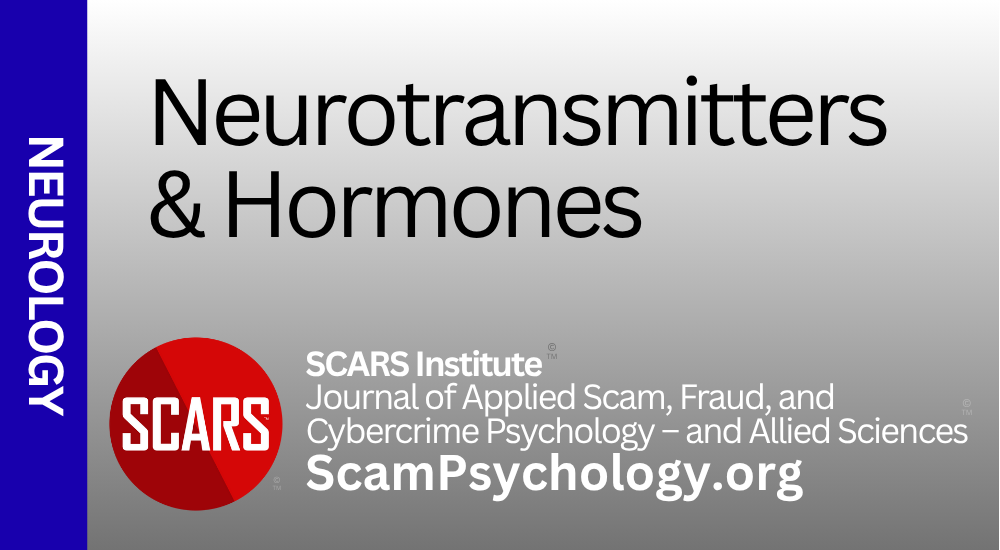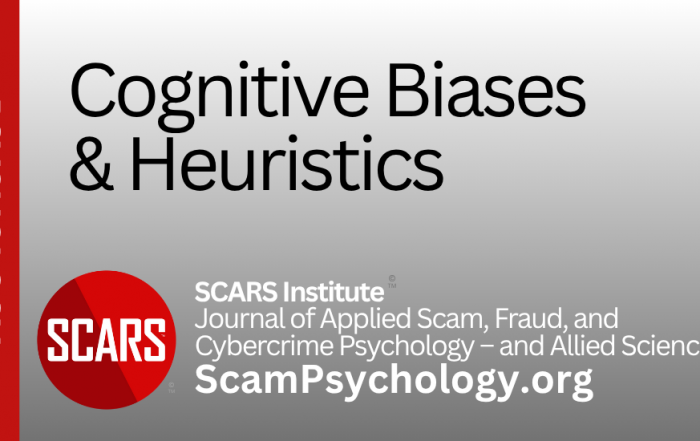About Hormones, Neurotransmitters, & Neuropeptides – An Overview
Facilitating Mental & Body Processes
Principal Category: Neurology
This page is a work in progress. More will be added as new exploration is performed.
Author:
• Tim McGuinness, PhD DFin, MCPO, MAnth – Anthropologist, Scientist, Director of the Society of Citizens Against Relationship Scams Inc.
• Portions from other sources – see below

Hormones & Neurotransmitters
Hormones and neurotransmitters are vital chemical messengers in the human body, playing crucial roles in regulating a wide array of physiological processes and behaviors.
Hormones are produced by glands in the endocrine system and are released into the bloodstream to target distant organs and tissues. They are responsible for regulating processes such as growth, metabolism, reproduction, and mood. Key hormones include insulin, which regulates blood sugar levels; cortisol, which helps manage stress; and estrogen and testosterone, which influence sexual development and reproduction.
Neurotransmitters, on the other hand, are chemicals released by neurons in the nervous system. They transmit signals across synapses, the gaps between nerve cells, enabling communication within the brain and throughout the body. These chemical messengers play a critical role in controlling mood, thought processes, and physical functions. For instance, serotonin is associated with mood regulation and well-being, dopamine with pleasure and reward, and acetylcholine with muscle activation and cognitive functions.
Neuropeptides are small protein-like molecules that act as neuromodulators. They influence neural activity and modulate the effects of neurotransmitters.
Together, hormones, neurotransmitters, and neuropeptides form an intricate network that maintains homeostasis and coordinates the body’s responses to internal and external stimuli. Understanding their functions and interactions is essential for grasping how the body maintains balance and responds to changes, both in health and disease.
Hormones
- Adrenaline: Adrenaline is produced in the medulla in the adrenal glands as well as some of the central nervous system’s neurons. Within a couple of minutes during a stressful situation, adrenaline is quickly released into the blood, sending impulses to organs to create a specific response.
- Aldosterone: Aldosterone is produced in the cortex of the adrenal glands, which are located above the kidneys. It affects the body’s ability to regulate blood pressure. It sends the signal to organs, like the kidney and colon, that can increase the amount of sodium the body sends into the bloodstream or the amount of potassium released in the urine. The hormone also causes the bloodstream to re-absorb water with sodium to increase blood volume. All of these actions are integral to increasing and lowering blood vessels. Indirectly, the hormone also helps maintain the blood’s pH and electrolyte levels.
- Cortisol: Cortisol is often called the “stress hormone” because of its connection to the stress response, however, cortisol is much more than just a hormone released during stress. Understanding cortisol and its effect on the body will help you balance your hormones and achieve good health. Cortisol is one of the steroid hormones and is made in the adrenal glands. Most cells within the body have cortisol receptors. Secretion of the hormone is controlled by the hypothalamus, the pituitary gland, and the adrenal gland, a combination of glands often referred to as the HPA axis.
- Dehydroepiandrosterone (DHEA): The brain controls the production of DHEA. The body uses a unique mechanism known as negative feedback to control the production of DHEA. Negative feedback tells your brain that once DHEA levels drop in your body, the mechanism is switched “on” and begins to produce more of the hormone. Once DHEA levels begin to rise, negative feedback is switched “off”.
- Norepinephrine / Noradrenaline: Norepinephrine also called noradrenaline is both a hormone, produced by the adrenal glands, and a neurotransmitter, a chemical messenger which transmits signals across nerve endings in the body. Norepinephrine is produced in the inner part of the adrenal glands, also called the adrenal medulla. The adrenal medulla also makes adrenaline (also known as epinephrine). Norepinephrine, adrenaline, and dopamine belong are part of the catecholamine family. Adrenal glands are making primarily adrenaline and most of the norepinephrine in the blood comes from nerve endings. It plays a role in your mood and ability to concentrate. Together with other hormones, norepinephrine helps the body respond to stress and exercise.
Neurotransmitters
Neurotransmitters are your body’s chemical messengers. They carry messages from one nerve cell across a space to the next nerve, muscle or gland cell. These messages help you move your limbs, feel sensations, keep your heart beating, and take in and respond to all information your body receives from other internal parts of your body and your environment.
Neurotransmitters transmit one of three possible actions in their messages, depending on the specific neurotransmitter.
- Excitatory. Excitatory neurotransmitters “excite” the neuron and cause it to “fire off the message,” meaning, the message continues to be passed along to the next cell. Examples of excitatory neurotransmitters include glutamate, epinephrine, and norepinephrine.
- Inhibitory. Inhibitory neurotransmitters block or prevent the chemical message from being passed along any further. Gamma-aminobutyric acid (GABA), glycine, and serotonin are examples of inhibitory neurotransmitters.
- Modulatory. Modulatory neurotransmitters influence the effects of other chemical messengers. They “tweak” or adjust how cells communicate at the synapse. They also affect a larger number of neurons at the same time.
How do Neurotransmitters Work?
You have billions of nerve cells in your body. Nerve cells are generally made up of three parts:
- A cell body. The cell body is vital to producing neurotransmitters and maintaining the function of the nerve cell.
- An axon. The axon carries the electrical signals along the nerve cell to the axon terminal.
- An axon terminal. This is where the electrical message is changed to a chemical signal using neurotransmitters to communicate with the next group of nerve cells, muscle cells, or organs.
Neurotransmitters are located in a part of the neuron called the axon terminal. They’re stored within thin-walled sacs called synaptic vesicles. Each vesicle can contain thousands of neurotransmitter molecules.
As a message or signal travels along a nerve cell, the electrical charge of the signal causes the vesicles of neurotransmitters to fuse with the nerve cell membrane at the very edge of the cell. The neurotransmitters, which now carry the message, are then released from the axon terminal into a fluid-filled space that’s between one nerve cell and the next target cell (another nerve cell, muscle cell, or gland).
In this space, called the synaptic junction, the neurotransmitters carry the message across less than 40 nanometers (nm) wide (by comparison, the width of a human hair is about 75,000 nm). Each type of neurotransmitter lands on and binds to a specific receptor on the target cell (like a key that can only fit and work in its partner lock). After binding, the neurotransmitter then triggers a change or action in the target cell, like an electrical signal in another nerve cell, a muscle contraction, or the release of hormones from a cell in a gland.
Types of Neurotransmitters
- Amino acids neurotransmitters: These neurotransmitters are involved in most functions of your nervous system.
- Glutamate: This is the most common excitatory neurotransmitter of your nervous system. It’s the most abundant neurotransmitter in your brain. It plays a key role in cognitive functions like thinking, learning, and memory. Imbalances in glutamate levels are associated with Alzheimer’s disease, dementia, Parkinson’s disease, and seizures.
- Gamma-aminobutyric acid (GABA): GABA is the most common inhibitory neurotransmitter of your nervous system, particularly in your brain. It regulates brain activity to prevent problems in the areas of anxiety, irritability, concentration, sleep, seizures, and depression.
- Glycine: Glycine is the most common inhibitory neurotransmitter in your spinal cord. Glycine is involved in controlling hearing processing, pain transmission, and metabolism.
- Monoamine neurotransmitters: These neurotransmitters play a lot of different roles in your nervous system and especially in your brain. Monoamine neurotransmitters regulate consciousness, cognition, attention, and emotion. Many disorders of your nervous system involve abnormalities of monoamine neurotransmitters, and many drugs that people commonly take affect these neurotransmitters.
- Histamine: Histamine regulates body functions including wakefulness, feeding behavior, and motivation. Histamine plays a role in asthma, bronchospasm, mucosal edema, and multiple sclerosis.
- Dopamine: Dopamine plays a role in your body’s reward system, which includes feeling pleasure, achieving heightened arousal, and learning. Dopamine also helps with focus, concentration, memory, sleep, mood, and motivation. Diseases associated with dysfunctions of the dopamine system include Parkinson’s disease, schizophrenia, bipolar disease, restless legs syndrome, and attention deficit hyperactivity disorder (ADHD). Many highly addictive drugs (cocaine, methamphetamines, amphetamines) act directly on the dopamine system.
- Epinephrine: Epinephrine (also called adrenaline) and norepinephrine (see below) are responsible for your body’s so-called “fight-or-flight response” to fear and stress. These neurotransmitters stimulate your body’s response by increasing your heart rate, breathing, blood pressure, blood sugar, and blood flow to your muscles, as well as heighten attention and focus to allow you to act or react to different stressors. Too much epinephrine can lead to high blood pressure, diabetes, heart disease, and other health problems. As a drug, epinephrine is used to treat anaphylaxis, asthma attacks, cardiac arrest, and severe infections.
- Norepinephrine: Norepinephrine (also called noradrenaline) increases blood pressure and heart rate. It’s most widely known for its effects on alertness, arousal, decision-making, attention, and focus. Many medications (stimulants and depression medications) aim to increase norepinephrine levels to improve focus or concentration to treat ADHD or to modulate norepinephrine to improve depression symptoms.
- Serotonin: Serotonin is an inhibitory neurotransmitter. Serotonin helps regulate mood, sleep patterns, sexuality, anxiety, appetite, and pain. Diseases associated with serotonin imbalance include seasonal affective disorder, anxiety, depression, fibromyalgia, and chronic pain. Medications that regulate serotonin and treat these disorders include selective serotonin reuptake inhibitors (SSRIs) and serotonin-norepinephrine reuptake inhibitors (SNRIs).
- Peptide neurotransmitters: Peptides are polymers or chains of amino acids.
- Endorphins: Endorphins are your body’s natural pain reliever. They play a role in our perception of pain. The release of endorphins reduces pain, as well as causes “feel good” feelings. Low levels of endorphins may play a role in fibromyalgia and some types of headaches.
- Acetylcholine: This excitatory neurotransmitter does a number of functions in your central nervous system (CNS [brain and spinal cord]) and in your peripheral nervous system (nerves that branch from the CNS). Acetylcholine is released by most neurons in your autonomic nervous system regulating heart rate, blood pressure and gut motility. Acetylcholine plays a role in muscle contractions, memory, motivation, sexual desire, sleep and learning. Imbalances in acetylcholine levels are linked with health issues, including Alzheimer’s disease, seizures, and muscle spasms.
After Neurotransmitters Are Used
What happens to neurotransmitters after they deliver their message?
After neurotransmitters deliver their message, the molecules must be cleared from the synaptic cleft (the space between the nerve cell and the next target cell). They do this in one of three ways.
- Fade away (a process called diffusion).
- They are reabsorbed and reused by the nerve cell that released it (a process called reuptake).
- They are broken down by enzymes within the synapse so it can’t be recognized or bind to the receptor cell (a process called degradation).
Neuropeptides
- Endorphins: Endorphins are your body’s natural pain reliever. They play a role in our perception of pain. The release of endorphins reduces pain, as well as causes “feel good” feelings. Low levels of endorphins may play a role in fibromyalgia and some types of headaches.
- Oxytocin: Oxytocin is a hormone and neuropeptide that plays a significant role in social bonding, reproduction, and childbirth. Often referred to as the “love hormone” or “cuddle hormone,” oxytocin is produced in the hypothalamus and released by the pituitary gland. It is involved in a wide range of physiological and psychological processes.
- Vasopressin
Difference between a Hormone, a Neurotransmitter, and a Neuropeptide
Hormones, neurotransmitters, and neuropeptides are all chemical messengers in the body, but they differ in their origin, mechanisms of action, and functions. Here’s a breakdown of the differences between them:
Hormones
Definition: Hormones are chemical substances produced by endocrine glands and released into the bloodstream to regulate various physiological processes in distant organs and tissues.
Origin: Produced by endocrine glands such as the pituitary gland, thyroid gland, adrenal glands, and pancreas.
Mode of Transport: Transported through the bloodstream to target organs and tissues.
Action: Hormones can have long-lasting effects and regulate processes such as growth, metabolism, reproduction, and stress responses.
Examples: Insulin, cortisol, estrogen, and thyroid hormones.
Neurotransmitters
Definition: Neurotransmitters are chemical messengers used by neurons to communicate with each other across synapses. They are released from the presynaptic neuron and bind to receptors on the postsynaptic neuron.
Origin: Synthesized and released by neurons.
Mode of Transport: Released into the synaptic cleft and act on neighboring neurons or effector cells (e.g., muscle cells).
Action: Neurotransmitters typically have rapid and short-lasting effects, playing critical roles in transmitting nerve impulses and regulating functions such as mood, cognition, and muscle contraction.
Examples: Dopamine, serotonin, acetylcholine, and gamma-aminobutyric acid (GABA).
Neuropeptides
Definition: Neuropeptides are small protein-like molecules that act as neuromodulators. They influence neural activity and modulate the effects of neurotransmitters.
Origin: Synthesized and released by neurons, often in conjunction with neurotransmitters.
Mode of Transport: Released into the synaptic cleft or extracellular space and act on neighboring neurons, modulating their activity.
Action: Neuropeptides have slower, longer-lasting effects compared to neurotransmitters. They modulate synaptic transmission, influence neuronal circuitry, and affect a range of brain functions such as pain perception, stress response, and social behavior.
Examples: Substance P, endorphins, oxytocin, and vasopressin.
Summary of Differences
Origin:
-
- Hormones: Produced by endocrine glands.
- Neurotransmitters: Synthesized by neurons.
- Neuropeptides: Synthesized by neurons, often in conjunction with neurotransmitters.
Mode of Transport:
-
- Hormones: Travel through the bloodstream.
- Neurotransmitters: Released into synaptic clefts.
- Neuropeptides: Released into synaptic clefts or extracellular space.
Action:
-
- Hormones: Long-lasting, affecting distant organs and tissues.
- Neurotransmitters: Rapid, short-lasting effects on neighboring neurons or effector cells.
- Neuropeptides: Slower, longer-lasting effects, modulating neural activity.
Function:
-
- Hormones: Regulate physiological processes such as growth, metabolism, and stress response.
- Neurotransmitters: Facilitate nerve impulse transmission and regulate functions like mood and cognition.
- Neuropeptides: Modulate synaptic transmission and influence a range of brain functions and behaviors.
Understanding these differences helps elucidate how the body coordinates complex physiological and psychological processes through various signaling mechanisms.
Portions courtesy of the Endocrine Society, Cleveland Clinic, and other sources.

Welcome to the SCARS INSTITUTE Journal of Scam Psychology
A Journal of Applied Scam, Fraud, and Cybercrime Psychology – and Allied Sciences
A dedicated site for psychology, victimology, criminology, applied sociology and anthropology, and allied sciences, published by the SCARS INSTITUTE™ – Society of Citizens Against Relationship Scams Inc.
TABLE OF CONTENTS
A Question of Trust
At the SCARS Institute, we invite you to do your own research on the topics we speak about and publish, Our team investigates the subject being discussed, especially when it comes to understanding the scam victims-survivors experience. You can do Google searches but in many cases, you will have to wade through scientific papers and studies. However, remember that biases and perspectives matter and influence the outcome. Regardless, we encourage you to explore these topics as thoroughly as you can for your own awareness.
Please Leave A Comment
Recent Comments
On Other Articles
on The Amygdala Hijack Effect And The Neurology Of Scam Victims – 2024: “I did research and found where the amygdala is located in the brain; however, I am interested in science. Thank…” Jan 2, 21:04
on Psychological Trauma & Stress And Its Effects On Sufferer’s Genetics – 2024: “Very interesting article. I have wondered sometimes if the way I respond to trauma was due to the trauma and…” Aug 14, 11:15
on Psychological Denial – A Maladaptive Coping Mechanism In Scam Victims – 2024: “I can see from this article how denial can become a coping mechanism for individuals after a scam. I myself…” Jul 15, 19:51
on Reductive Thinking – A Maladaptive Coping Mechanism – An Enemy Of Scam Victims Recovery – 2024: “Very good article that explained the differences between reductive thinking and minimizing. I’m not sure but it seems that minimizing…” Jul 13, 20:14
on Self-Hate In Scam Victims And Its Impact From Psychological Trauma – 2024: “At one time in my life I felt self hate and I did at one point want to end my…” Jul 6, 15:23
A Note About Labeling!
We often use the term ‘scam victim’ in our articles, but this is a convenience to help those searching for information in search engines like Google. It is just a convenience and has no deeper meaning. If you have come through such an experience, YOU are a Survivor! It was not your fault. You are not alone! Axios!
Statement About Victim Blaming
Some of our articles discuss various aspects of victims. This is both about better understanding victims (the science of victimology) and their behaviors and psychology. This helps us to educate victims/survivors about why these crimes happened and to not blame themselves, better develop recovery programs, and to help victims avoid scams in the future. At times this may sound like blaming the victim, but it does not blame scam victims, we are simply explaining the hows and whys of the experience victims have.
These articles, about the Psychology of Scams or Victim Psychology – meaning that all humans have psychological or cognitive characteristics in common that can either be exploited or work against us – help us all to understand the unique challenges victims face before, during, and after scams, fraud, or cybercrimes. These sometimes talk about some of the vulnerabilities the scammers exploit. Victims rarely have control of them or are even aware of them, until something like a scam happens and then they can learn how their mind works and how to overcome these mechanisms.
Articles like these help victims and others understand these processes and how to help prevent them from being exploited again or to help them recover more easily by understanding their post-scam behaviors. Learn more about the Psychology of Scams at www.ScamPsychology.org
Psychology Disclaimer:
All articles about psychology, neurology, and the human brain on this website are for information & education only
The information provided in these articles is intended for educational and self-help purposes only and should not be construed as a substitute for professional therapy or counseling.
While any self-help techniques outlined herein may be beneficial for scam victims seeking to recover from their experience and move towards recovery, it is important to consult with a qualified mental health professional before initiating any course of action. Each individual’s experience and needs are unique, and what works for one person may not be suitable for another.
Additionally, any approach may not be appropriate for individuals with certain pre-existing mental health conditions or trauma histories. It is advisable to seek guidance from a licensed therapist or counselor who can provide personalized support, guidance, and treatment tailored to your specific needs.
If you are experiencing significant distress or emotional difficulties related to a scam or other traumatic event, please consult your doctor or mental health provider for appropriate care and support.
Also, please read our SCARS Institute Statement About Professional Care for Scam Victims – here
If you are in crisis, feeling desperate, or in despair please call 988 or your local crisis hotline.
SCARS Institute Resources:
- If you are a victim of scams go to www.ScamVictimsSupport.org for real knowledge and help
- Enroll in SCARS Scam Survivor’s School now at www.SCARSeducation.org
- To report criminals visit https://reporting.AgainstScams.org – we will NEVER give your data to money recovery companies like some do!
- Sign up for our free support & recovery help by https://support.AgainstScams.org
- Follow us and Find our podcasts, webinars, and helpful videos on YouTube: https://www.youtube.com/@RomancescamsNowcom
- SCARS Institute Songs for Victim-Survivors: https://www.youtube.com/playlist…
- See SCARS Institute Scam Victim Self-Help Books at https://shop.AgainstScams.org
- Learn about the Psychology of Scams at www.ScamPsychology.org
- Dig deeper into the reality of scams, fraud, and cybercrime at www.ScamsNOW.com and www.RomanceScamsNOW.com
- Scam Survivor’s Stories: www.ScamSurvivorStories.org
- For Scam Victim Advocates visit www.ScamVictimsAdvocates.org
- See more scammer photos on www.ScammerPhotos.com














![niprc1.png1_-150×1501-11[1]](https://scampsychology.org/wp-content/uploads/2025/05/niprc1.png1_-150x1501-111.webp)